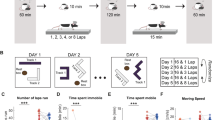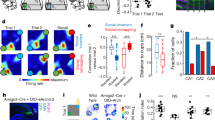Abstract
The hippocampus is thought to be involved in episodic memory formation by reactivating traces of waking experience during sleep. Indeed, the joint firing of spatially tuned pyramidal cells encoding nearby places recur during sleep. We found that the sleep cofiring of rat CA1 pyramidal cells encoding similar places increased relative to the sleep session before exploration. This cofiring increase depended on the number of times that cells fired together with short latencies (<50 ms) during exploration, and was strongest between cells representing the most visited places. This is indicative of a Hebbian learning rule in which changes in firing associations between cells are determined by the number of waking coincident firing events. In contrast, cells encoding different locations reduced their cofiring in proportion to the number of times that they fired independently. Together these data indicate that reactivated patterns are shaped by both positive and negative changes in cofiring, which are determined by recent behavior.
This is a preview of subscription content, access via your institution
Access options
Subscribe to this journal
Receive 12 print issues and online access
$209.00 per year
only $17.42 per issue
Buy this article
- Purchase on Springer Link
- Instant access to full article PDF
Prices may be subject to local taxes which are calculated during checkout






Similar content being viewed by others
References
Squire, L.R. Memory and the hippocampus: a synthesis from findings with rats, monkeys and humans. Psychol. Rev. 99, 195–231 (1992).
O'Keefe, J. & Nadel, L. Hippocampus as a Cognitive Map (Oxford University Press, Oxford, 1978).
Morris, R.G., Garrud, P., Rawlins, J.N. & O'Keefe, J. Place navigation impaired in rats with hippocampal lesions. Nature 297, 681–683 (1982).
Buzsaki, G. Two-stage model of memory trace formation: a role for 'noisy' brain states. Neuroscience 31, 551–570 (1989).
McClelland, J.L., McNaughton, B.L. & O'Reilly, R.C. Why there are complementary learning systems in the hippocampus and neocortex: insights from the successes and failures of connectionist models of learning and memory. Psychol. Rev. 102, 419–457 (1995).
Wilson, M.A. & McNaughton, B.L. Reactivation of hippocampal ensemble memories during sleep. Science 265, 676–679 (1994).
Morris, R.G. Elements of a neurobiological theory of hippocampal function: the role of synaptic plasticity, synaptic tagging and schemas. Eur. J. Neurosci. 23, 2829–2846 (2006).
Pavlides, C. & Winson, J. Influences of hippocampal place cell firing in the awake state on the activity of these cells during subsequent sleep episodes. J. Neurosci. 9, 2907–2918 (1989).
Hirase, H., Leinekugel, X., Czurko, A., Csicsvari, J. & Buzsaki, G. Firing rates of hippocampal neurons are preserved during subsequent sleep episodes and modified by novel awake experience. Proc. Natl. Acad. Sci. USA 98, 9386–9390 (2001).
Battaglia, F.P., Sutherland, G.R., Cowen, S.L., Mc Naughton, B.L. & Harris, K.D. Firing rate modulation: a simple statistical view of memory trace reactivation. Neural Netw. 18, 1280–1291 (2005).
O'Neill, J., Senior, T. & Csicsvari, J. Place-selective firing of CA1 pyramidal cells during sharp wave/ripple network patterns in exploratory behavior. Neuron 49, 143–155 (2006).
Skaggs, W.E. & McNaughton, B.L. Replay of neuronal firing sequences in rat hippocampus during sleep following spatial experience. Science 271, 1870–1873 (1996).
Louie, K. & Wilson, M.A. Temporally structured replay of awake hippocampal ensemble activity during rapid eye movement sleep. Neuron 29, 145–156 (2001).
Lee, A.K. & Wilson, M.A. Memory of sequential experience in the hippocampus during slow wave sleep. Neuron 36, 1183–1194 (2002).
Nadasdy, Z., Hirase, H., Czurko, A., Csicsvari, J. & Buzsaki, G. Replay and time compression of recurring spike sequences in the hippocampus. J. Neurosci. 19, 9497–9507 (1999).
Kudrimoti, H.S., Barnes, C.A. & McNaughton, B.L. Reactivation of hippocampal cell assemblies: effects of behavioral state, experience and EEG dynamics. J. Neurosci. 19, 4090–4101 (1999).
Foster, D.J. & Wilson, M.A. Reverse replay of behavioural sequences in hippocampal place cells during the awake state. Nature 440, 680–683 (2006).
Jackson, J.C., Johnson, A. & Redish, A.D. Hippocampal sharp waves and reactivation during awake states depend on repeated sequential experience. J. Neurosci. 26, 12415–12426 (2006).
Csicsvari, J., O'Neill, J., Allen, K. & Senior, T. Place-selective firing contributes to the reverse-order reactivation of CA1 pyramidal cells during sharp waves in open-field exploration. Eur. J. Neurosci. 26, 704–716 (2007).
Chrobak, J.J. & Buzsaki, G. Selective activation of deep layer (V–VI) retrohippocampal cortical neurons during hippocampal sharp waves in the behaving rat. J. Neurosci. 14, 6160–6170 (1994).
Buzsaki, G. Hippocampal sharp waves: their origin and significance. Brain Res. 398, 242–252 (1986).
Csicsvari, J., Hirase, H., Mamiya, A. & Buzsaki, G. Ensemble patterns of hippocampal CA3–CA1 neurons during sharp wave–associated population events. Neuron 28, 585–594 (2000).
Ylinen, A. et al. Sharp wave–associated high-frequency oscillation (200 Hz) in the intact hippocampus: network and intracellular mechanisms. J. Neurosci. 15, 30–46 (1995).
Bostock, E., Muller, R.U. & Kubie, J.L. Experience-dependent modifications of hippocampal place cell firing. Hippocampus 1, 193–205 (1991).
Muller, R.U. & Kubie, J.L. The effects of changes in the environment on the spatial firing of hippocampal complex-spike cells. J. Neurosci. 7, 1951–1968 (1987).
Shen, B. & McNaughton, B.L. Modeling the spontaneous reactivation of experience-specific hippocampal cell assembles during sleep. Hippocampus 6, 685–692 (1996).
Hebb, D.O. The Organization of Behavior: a Neuropsychological Theory (Lawrence Erlbaum Associates, New York, 1949).
Huerta, P.T. & Lisman, J.E. Bidirectional synaptic plasticity induced by a single burst during cholinergic theta oscillation in CA1 in vitro. Neuron 15, 1053–1063 (1995).
Markram, H., Lubke, J., Frotscher, M. & Sakmann, B. Regulation of synaptic efficacy by coincidence of postsynaptic APs and EPSPs. Science 275, 213–215 (1997).
Magee, J.C. & Johnston, D. A synaptically controlled, associative signal for Hebbian plasticity in hippocampal neurons. Science 275, 209–213 (1997).
Bi, G.Q. & Poo, M.M. Synaptic modifications in cultured hippocampal neurons: dependence on spike timing, synaptic strength and postsynaptic cell type. J. Neurosci. 18, 10464–10472 (1998).
Paulsen, O. & Sejnowski, T.J. Natural patterns of activity and long-term synaptic plasticity. Curr. Opin. Neurobiol. 10, 172–179 (2000).
Nakazawa, K. et al. Requirement for hippocampal CA3 NMDA receptors in associative memory recall. Science 297, 211–218 (2002).
Kentros, C. et al. Abolition of long-term stability of new hippocampal place cell maps by NMDA receptor blockade. Science 280, 2121–2126 (1998).
Wittenberg, G.M. & Wang, S.S. Malleability of spike timing–dependent plasticity at the CA3–CA1 synapse. J. Neurosci. 26, 6610–6617 (2006).
Golding, N.L., Staff, N.P. & Spruston, N. Dendritic spikes as a mechanism for cooperative long-term potentiation. Nature 418, 326–331 (2002).
Lisman, J. & Spruston, N. Postsynaptic depolarization requirements for LTP and LTD: a critique of spike timing–dependent plasticity. Nat. Neurosci. 8, 839–841 (2005).
Li, S., Cullen, W.K., Anwyl, R. & Rowan, M.J. Dopamine-dependent facilitation of LTP induction in hippocampal CA1 by exposure to spatial novelty. Nat. Neurosci. 6, 526–531 (2003).
Nitz, D. & McNaughton, B. Differential modulation of CA1 and dentate gyrus interneurons during exploration of novel environments. J. Neurophysiol. 91, 863–872 (2004).
Giovannini, M.G. et al. Effects of novelty and habituation on acetylcholine, GABA and glutamate release from the frontal cortex and hippocampus of freely moving rats. Neuroscience 106, 43–53 (2001).
Castro, C.A., Silbert, L.H., McNaughton, B.L. & Barnes, C.A. Recovery of spatial learning deficits after decay of electrically induced synaptic enhancement in the hippocampus. Nature 342, 545–548 (1989).
Moser, E.I., Krobert, K.A., Moser, M.B. & Morris, R.G. Impaired spatial learning after saturation of long-term potentiation. Science 281, 2038–2042 (1998).
Brun, V.H., Ytterbo, K., Morris, R.G., Moser, M.B. & Moser, E.I. Retrograde amnesia for spatial memory induced by NMDA receptor–mediated long-term potentiation. J. Neurosci. 21, 356–362 (2001).
Csicsvari, J., Hirase, H., Czurko, A. & Buzsaki, G. Reliability and state dependence of pyramidal cell–interneuron synapses in the hippocampus: an ensemble approach in the behaving rat. Neuron 21, 179–189 (1998).
Harris, K.D., Hirase, H., Leinekugel, X., Henze, D.A. & Buzsaki, G. Temporal interaction between single spikes and complex spike bursts in hippocampal pyramidal cells. Neuron 32, 141–149 (2001).
Csicsvari, J., Hirase, H., Czurko, A., Mamiya, A. & Buzsaki, G. Oscillatory coupling of hippocampal pyramidal cells and interneurons in the behaving Rat. J. Neurosci. 19, 274–287 (1999).
Acknowledgements
We thank G. Buzsaki, A. Czurko, D. Dupret, T. Klausberger, O. Paulsen, B. Pleydell-Bouverie, O. Potvin and P. Somogyi for their constructive comments on a previous version of the manuscript, and N. Campo-Urriza for the technical assistance. This work was supported by the Medical Research Council. T.J.S. and K.A. are funded by the Wellcome Trust.
Author information
Authors and Affiliations
Contributions
J.O. carried out the data analysis. T.J.S., J.O., J.C. and K.A. conducted the experiments and spike clustering. J.C., J.O. and J.R.H. wrote the manuscript. J.C. supervised the project.
Corresponding author
Supplementary information
Supplementary Text and Figures
Supplementary Figures 1–5 and Methods (PDF 4255 kb)
Rights and permissions
About this article
Cite this article
O'Neill, J., Senior, T., Allen, K. et al. Reactivation of experience-dependent cell assembly patterns in the hippocampus. Nat Neurosci 11, 209–215 (2008). https://doi.org/10.1038/nn2037
Received:
Accepted:
Published:
Issue Date:
DOI: https://doi.org/10.1038/nn2037
This article is cited by
-
Repeated stress exposure leads to structural synaptic instability prior to disorganization of hippocampal coding and impairments in learning
Translational Psychiatry (2022)
-
Integrating new memories into the hippocampal network activity space
Nature Neuroscience (2021)
-
An emergent neural coactivity code for dynamic memory
Nature Neuroscience (2021)
-
Navigating for reward
Nature Reviews Neuroscience (2021)
-
Grid cell co-activity patterns during sleep reflect spatial overlap of grid fields during active behaviors
Nature Neuroscience (2019)



